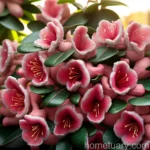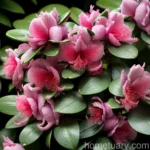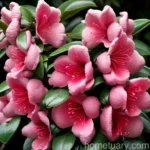The Deciduous Azalea: Rhododendron ‘Snow White’
What is a Deciduous Azalea?
Deciduous azaleas, known scientifically as Rhododendron, are a beautiful and diverse group of plants that belong to the Ericaceae family. One particularly stunning variety is the Rhododendron ‘Snow White,’ which boasts delicate white blooms and vibrant green foliage. These plants are popular for their ornamental value and are prized by gardeners for their ability to add charm and elegance to landscapes.
Key Takeaways
As we delve into the world of the deciduous azalea, it’s important to keep a few key takeaways in mind:
- Plant Name: Deciduous Azalea (Rhododendron ‘Snow White’)
- Common Names: Snow White Azalea Plant
- Watering: Maintain consistent moisture levels
- Sunlight: Thrives in partial shade
- Fertilizer: Requires acidic soil and periodic feeding
- Soil: Well-draining and acidic soil is ideal
- Pruning: Minimal pruning required
- Propagation: Can be propagated through cuttings
- Container Popularity: Suitable for container gardening
- Common Diseases: Potential susceptibility to certain diseases
- Common Pests: Vulnerable to specific pests
- Fun Facts: Fascinating insights into the plant’s characteristics
Culture: Understanding the Deciduous Azalea
Uses
Deciduous azaleas are commonly used for ornamental purposes, adding a burst of color and elegance to landscapes and gardens. Their vibrant blooms and lush foliage make them a popular choice for landscaping, where they can be used as standalone plants or incorporated into mixed borders and floral displays.
Water
The watering requirements of the Rhododendron ‘Snow White’ are relatively high, necessitating consistent moisture levels to thrive. Adequate watering, especially during dry periods, is crucial to support the health and vibrancy of these plants.
Sunlight
While deciduous azaleas can tolerate some direct sunlight, they generally prefer partial shade. Placing them in locations that receive dappled sunlight or partial shade provides the ideal growing conditions for these beautiful plants.
Fertilizer
Fertilizing deciduous azaleas is essential for promoting healthy growth and vibrant blooms. These plants thrive in acidic soil, which should be supplemented with a suitable fertilizer formulated for acid-loving plants. Applying a balanced, slow-release fertilizer in spring can support their growth and blooming.
Soil
The soil requirements of the Rhododendron ‘Snow White’ are specific, as they prefer well-draining, acidic soil. An ideal mix may include organic matter such as peat moss or compost, which not only aids in maintaining soil acidity but also supports moisture retention and overall plant health.
Pruning
Minimal pruning is typically necessary for deciduous azaleas. Regular removal of dead or damaged branches can help maintain their shape and health, while rejuvenation pruning can be performed after flowering to encourage new growth.
Propagation
Deciduous azaleas such as the Rhododendron ‘Snow White’ can be propagated through various methods, including stem cuttings. By following proper techniques and providing the right conditions, these plants can be successfully propagated to expand their presence in the garden or to share with others.
Container Popularity
Due to their manageable size and striking beauty, deciduous azaleas are well-suited for container gardening. Their compact nature and captivating blooms make them an excellent choice for adorning patios, decks, and other outdoor living spaces.
Common Diseases and Pests
Common Diseases
While deciduous azaleas are generally resilient, they can be susceptible to certain diseases. Common issues include powdery mildew, root rot, and rust diseases, which can impact their health and appearance if not addressed promptly.
Disease Diagnosis
Diagnosing diseases in deciduous azaleas involves careful observation of symptoms such as leaf discoloration, deformation, or unusual growth patterns. Prompt identification and treatment are crucial for managing and preventing the spread of diseases.
Common Pests
Deciduous azaleas can fall victim to specific pests, including lace bugs and spider mites. Vigilance and proactive pest management practices are essential for protecting these plants from infestations and minimizing potential damage.
Botanist’s Tips
For optimal care and maintenance of the Rhododendron ‘Snow White’ and other deciduous azaleas, consider the following tips from botanists and horticultural experts:
- Keep the soil consistently moist, but avoid waterlogging.
- Ensure adequate air circulation around the plants to minimize disease risks.
- Prune sparingly, focusing on removing dead or damaged branches.
- Apply a layer of mulch around the base of the plants to retain moisture and deter weeds.
- Monitor for signs of pests and diseases, intervening promptly if issues arise.
Fun Facts About Deciduous Azaleas
Delve into the captivating world of deciduous azaleas with these intriguing facts:
- Deciduous azaleas belong to the Rhododendron genus, which encompasses a diverse array of plant species.
- Their blooms come in an assortment of colors, ranging from delicate pastels to vibrant hues, offering a wide range of options for gardeners.
- Some deciduous azalea varieties are prized for their captivating fragrance, adding an extra dimension to their appeal.
- These plants play a role in supporting pollinators, attracting bees, butterflies, and other beneficial insects to the garden.
- Deciduous azaleas are known for their brilliant fall foliage, showcasing stunning color displays before their leaves drop in autumn.
Links to External Resources
Explore further insights and guidance on the care and cultivation of deciduous azaleas with these valuable resources:
In the realm of horticulture, the deciduous azalea holds a special place, enchanting enthusiasts with its exquisite blooms and enduring appeal. By understanding its specific needs and characteristics, gardeners can create thriving landscapes adorned with the beauty of the Rhododendron ‘Snow White’ and other captivating varieties. Whether nestled in a garden bed or showcased in a decorative container, the allure of these plants continues to captivate and inspire.















